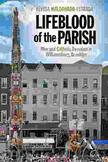Review: The rituals of a Brooklyn Catholic community
There is good news as well as some less cheerful tidings in Lifeblood of the Parish: Men and Catholic Devotion in Williamsburg, Brooklyn, an ethnographic look at Italian-American communal rituals in New York. The author conducted years of fieldwork at the Shrine Church of Our Lady of Mount Carmel in Brooklyn, and the book focuses on the men who are central to the production of the parish’s annual Feast of Our Lady of Mount Carmel and San Paolino (St. Paulinus, the patron saint of Nola, Italy).
The feast’s most eye-catching ritual is the Dance of the Giglio, during which volunteers carry a 70-foot tall, four-ton tower through the streets. Never a liturgical event, the Giglio has nevertheless united the community for over a century.
‘Lifeblood of the Parish’ is an ethnographic look at Italian-American communal rituals in the Williamsburg neighborhood of Brooklyn.
Maldonado-Estrada asserts that male bonding to support the parish marks a positive development for an otherwise fragmented neighborhood. Yet she also acknowledges that the precise amount of spirituality found in this version of muscular Christianity is difficult to pinpoint. Negative side effects include drunken rowdyism and incidents where participants accost pedestrians to demand donations to the church.
The ethnographer’s tone here is generally approving of the macho goings-on as the “making of masculinity” and a celebration of the “Catholic male body.” Some of the brashness may be more redolent of the neighborhood than of Italian-American Catholicism. Archaic gender divisions prevail, so women work in subsidiary roles during the feast, and gay men are shunned. A longtime volunteer was forced to resign in 2014 from directing the shrine because he had legally married his male partner, and the pastor of the parish could no longer “pretend he did not know about [the volunteer’s] sexuality, now that he was married.”
A Coney Island fairground element is present. Devotion, instead of being expressed by study or prayer, is shown by lifting weights, getting tattooed and other activities befitting the annual Fourth of July hot dog eating contest and other crowd-pleasing spectacles.
The French medieval legends of The Juggler of Notre Dame and its close cousin, Our Lady’s Tumbler, are relevant to this story. As the literary historian Jan Ziolkowski noted in The Juggler of Notre Dame and the Medievalizing of Modernity, all gifts offered in devotion are acceptable, although it should be recalled that the juggler Barnabe had taken holy orders before demonstrating his skills in front of a statue of the Virgin Mary, and is nowhere described as drunk, tattooed or homophobic.










